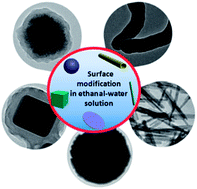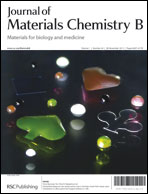A versatile ethanol-mediated polymerization of dopamine for efficient surface modification and the construction of functional core–shell nanostructures†
Abstract
A versatile ethanol-mediated oxidative polymerization of dopamine is demonstrated for the effective surface modification of nanomaterials. The presence of ethanol is found to significantly slow down the polymerization rate of dopamine and make the surface modification of nanomaterials with polydopamine more controllable in comparison to the water-phase polymerization. Various nanomaterials with different morphologies and surface properties, including one-dimensional (1-D) CNTs and iron oxide nanorods, 2-D nanodiscs, silver nanocubes and magnetite particles, were successfully modified by a layer of PDA with a controllable thickness from 5 to 100 nm, giving rise to PDA-shelled nanocomposites with well-defined structures and excellent water dispersibility. As exemplified by the case of magnetite particles, the PDA coating can dramatically reduce the cytotoxicity of nanomaterials and enhance their biocompatibility. This method is facile and particularly suitable for the surface engineering of nanomaterials, and thus promising for designing various functional nanostructures for a broad range of applications, such as drug delivery, protein purification, enzyme immobilization, and chemo/biosensing.


 Please wait while we load your content...
Please wait while we load your content...